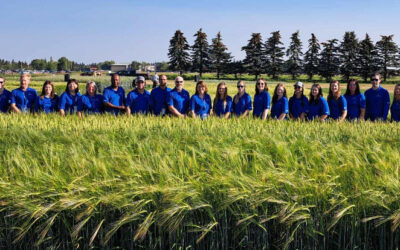As seeding season draws near, it’s worth taking another look at seeding rates in cereals.
According to Sheri Strydhorst, agronomy research scientist with Alberta Agriculture and Forestry (AAF), simply put, higher seeding rates equals higher plant populations. And that, in turn, equals more main heads and less tillers.
“The real benefit is increased uniformity in your plant population across your field,” she says. “When you have more plants, they have fewer tillers and that means all of those heads will be at the same growth stage.”
This increased uniformity leads to everything flowering at the same time, making fungicide applications easier, presenting a shorter window for pests such as wheat midge, and less infection time for diseases such as ergot or Fusarium head blight.
“If we have early-season disease or frost or insect damage, having more seeds allows you to make sure if some of those are lost in the spring, you’re not at a critically low plant population,” notes Strydhorst. “The other thing is increased competition with weeds. As we get more and more herbicide-resistant weeds, we need to depend on agronomic tools from the system, not just herbicides. The more plant competition you have from your crop, the better your herbicides are going to work.”
Brian Beres, research scientist with Agriculture and Agri-Food Canada at Lethbridge, has conducted scads of seeding rate work on spring and winter wheat. He says besides potential for higher yields, there are secondary benefits that come into the mix. For instance, wheat’s competitive ability.
“We conducted multiple studies on winter wheat and were able to show how important higher seeding rates were in managing weed competition which is significant as you achieve early canopy closure with high plant populations,” he says.
“The result is better control of weeds. Also, a key feature of high seeding rates is replacing those secondary tillers with more main stems per unit area, resulting in a much more uniform crop stage, so you get higher fungicide efficacy. This is also likely to shorten the flowering period as well as days to maturity, so the grower is going to be able to harvest earlier, and as we found last fall, can be an important asset.”
Beres says his emphasis is shifting from the practice of thinking of seeding in terms of a volume or a bulk per unit area, to a spatial density per unit area. So, seeds per square metre or per square foot. “The problem is that the ‘bushels per acre’ rule of thumb resulted in a lot of plant stand variation from one class of wheat to another because kernel size, shape and weight varies considerably and more so now, even within classes, given that kernel visual distinguishability has been phased out as of 2008,” he says.
“For example, we had many growers back in the old days who, even with winter wheat, went at about 200 seeds per sq. m., or 20 seeds per sq. ft. We were able to show that that needs to be up around 450 seeds per sq. m. We were able to show with those high-yielding classes such as durum or the high-yielding varieties within CWRS, they could withstand the higher density and not lodge.
“As a starting point, the ‘sweet spot’ for winter wheat would be 450 seeds per sq. m.; and for springs across the board, 400 seeds per sq. m., but some high-yielding, strong-strawed spring varieties are definitely going to respond to rates higher than that as well.”
No matter your variety of wheat, Beres stresses the importance of ensuring a good germination rate and good vigour. But equally important is calibration.
“Growers need to think about planting spatially per unit area, such as 40 to 45 seeds per sq. ft., and that they know what their kernel weight is,” he says. “The kernel weight can alter what they think their planting is, it’s pretty significant.”







